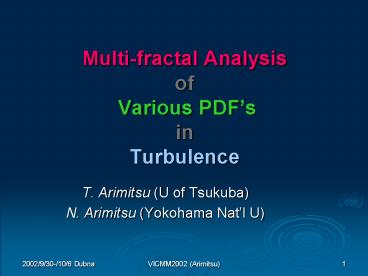Multi-fractal Analysis of Various PDF PowerPoint PPT Presentation
1 / 18
Title: Multi-fractal Analysis of Various PDF
1
Multi-fractal Analysis of Various
PDFsinTurbulence
- T. Arimitsu (U of Tsukuba)
- N. Arimitsu (Yokohama Natl U)
2
The multifractal analysis is a unified
self-consistent approach (no adjustable
parameters) based on generalized entropy, i.e.,
the Tsallis or the Renyi entropy.
Multi-fractal Analysis
It rests
- on the scale invariance of the Navier-Stokes
equation for high Reynolds number, - which causes singularities in velocity
fluctuations, velocity derivatives and fluid
particle accelerations, - and on the assumptions that the singularities
distribute themselves multifractally in physical
space, - whose distribution function is given by taking
extremum of the generalized entropy under the
appropriate constraints.
If one starts with the Boltzmann entropy, the
multifractal analysis provides us with the
log-normal model (Kolmogorov 1962).
3
- The various PDF's
- measured in the real experiment by Lewis and
Swinney for turbulent Couette-Taylor flow
produced in a concentric cylinder system, - observed in the DNS (10243-mesh) by Gotoh et al.
and - obtained in the real experiment by Bodenschatz et
al. for fluid particle accelerations in the
Lagrangian frame measurement
Experiments
- are analyzed in excellent agreement with the
theoretical formulae for the corresponding PDF
derived by the multifractal analysis. - DNS Direct Numerical Simulation
- See, for example, T.A. N.A., J.Phys.Cond.Matt.
14 (2002) 2237.
4
- In this talk, the PDF's
- measured in the real experiment by Lewis and
Swinney for turbulent Couette-Taylor flow
produced in a concentric cylinder system, - observed in the DNS by Gotoh et al. and
- obtained in the real experiment by Bodenschatz et
al. for fluid particle accelerations in the
Lagrangian frame measurement
Experiments
are analyzed in excellent agreement with the
theoretical formulae for the corresponding PDF
derived by the multifractal analysis of the
singularities due to the scaling invariance of
the Navier-Stokes equation. DNS Direct
Numerical Simulation See, for example, T.A.
N.A., J.Phys.Cond.Matt. 14 (2002) 2237.
5
r
Vortex Structures
Rel 220.7
- by M. Tanahashi (TIT)
6
PDF of velocity fluctuations
longitudinal
Closed circlesExperimental PDF by Gotoh et al.
(2002) r/? from top to bottom 2.38, 4.76, 9.52,
19.0, 38.1, 76.2, 152, 305, 609,
1220 LinesTheoretical PDF with q 0.391
(µ0.240) by AA (2001) n from top to
bottom 21.5, 20.0, 16.8, 14.0, 11.8, 10.1, 9.30,
8.10, 7.00, 6.00 n number of multifractal
steps For better visibility, each PDF is shifted
by 1 unit along the vertical axis.
Gotohs Experiment
xn velocity fluctuation normalized by its
deviation
7
Dependence of n on r/?
lcT /? 42.57
Gotohs Experiment
There appears two distinct scaling regions in the
inertial range separated by nearly the Taylor
microscale ?/?38.33.
lcL /? 48.26
8
Contour surfaces of the second invariant of the
velocity gradient tensor.
by M. Tanahashi at TIT
Vortex Structures
lt20h,20h -40h
20h - 40h ,40h - 80h
80h-160h ,160hgt
Rel175.4 30h ? l
9
- In this talk, the PDF's
- measured in the real experiment by Lewis and
Swinney for turbulent Couette-Taylor flow
produced in a concentric cylinder system, - observed in the DNS by Gotoh et al. and
- obtained in the real experiment by Bodenschatz et
al. for fluid particle accelerations in the
Lagrangian frame measurement
Experiments
are analyzed in excellent agreement with the
theoretical formulae for the corresponding PDF
derived by the multifractal analysis of the
singularities due to the scaling invariance of
the Navier-Stokes equation. See, for example,
T.A. N.A., J.Phys.Cond.Matt. 14 (2002) 2237.
10
Trajectories of a fluid particle in turbulence.
Vortex Structures
Rel 220.7
- by M. Tanahashi (TIT)
11
Bodenschatzs Experiment
Rl 970
The 3-D time-resolved trajectory of a
46-mm-diameter particle in a turbulent water
flow. A sphere marks the measured position of
the particle in each of 300 frames taken every
0.014 msec (th/201/2). The shading indicates
the acceleration magunitude, with the maximum
value of 12,000 msec-2 corresponding to 30
standard deviations.
12
Bodenschatzs Experiment
13
PDF of fluid particle accelerations (Bodenschatz
et al.)
Open squares and circles Experimental PDF by
Bodenschatz et al. (2001) LinesTheoretical PDF
with q 0.431 (µ0.259) by AA (2002) n
16.4 n number of multifractal steps
Present Analysis
wn velocity fluctuation normalized by its
deviation
14
PDF of fluid particle accelerations (Gotoh et al.)
DNS by Gotoh et al. R? 380
Present Analysis
Gotoh et al.
present theory
log normal model
15
- What we learned here is that multifractal
structure may come out, in general, when a
cascade process, such as an energy cascade,
appears in stationary state. - The success of this multifractal analysis may
provide us with some new aspect for the
construction of dynamical approach to turbulence,
e.g., a derivation of the turbulent viscosity by
a RG method for multifractal systems. - Much deeper physical interpretation of turbulence
by means of the present analysis may also help us
in the further understanding of other systems
with large deviations, such as - the distribution of relative velocities of stars
and galaxies, - the distribution of currency changes,
- and ..
Summary
16
M. Tsubota et al., Phys. Rev. B 62, 11751 (2000)
- The system of vortex tangle (Feynman 1955) in
superfluid He II is attractive in order to
understand the new scaling region found in the
present work, and to create the RG method for
multifractal systems. - Temperature-independent vortex decay mechanism
below T70 mK has been observed in superfluid 4He
(David et al. 2000). - Kolmogorov spectrum (K41) was observed in
non-frictional suferfluid He II (Tsubota et al.
2002).
Summary
LIA Localized induction approximation
17
Decay of vortex tangle in He II
by M. Tsubota at Osaka City Univ.
Interaction between vortices and normal fluid ?
Yes
No
Vortex Tangle
18
Visualization of vortexes in turbulence is one of
the progressing techniques in numerical
simulations. We hope that you will do this! Give
us the PDFs obtained in your numerical
simulations in turbulence!! We would like to
analyze your data by the multifractal analysis!!!
Thank you for your attention.

